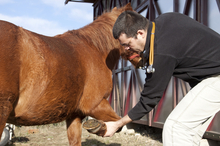In a news release, Animed Veterinary Hospital & Equine Unit in Shedfield, UK, discusses laminitis, one of the most frightening diseases with which equine owners must contend.

Veterinarian doing a check for laminitis
With spring approaching, all horse owners need to be aware of ways of recognizing and preventing laminitis as well as when to call a veterinarian if laminitis is suspected in an equine.
"It is the diagnosis horse owners dread â 'your horse has laminitis.' Prevention is the best way to approach this disease as there is no true cure. There are, however, better treatments now than ever before, but laminitisâs painful swelling can still be a death sentence."
Laminitis is one of the most serious, crippling diseases of horses, ponies and donkeys. Severe and recurring cases of laminitis can reduce a horseâs usefulness or result in the horse being destroyed to prevent further suffering. Treatment can require a lot of time and money (whether successful or not) and requires a good deal of energy from the carer for an extended period of time.
Recent research has shown a strong association between the high insulin levels seen in most ponies with Cushingâs Disease (Pituitary Pars Intermedia Disease (PPID)) and Equine Metabolic Syndrome (EMS) and susceptibility to laminitis; indeed it is now thought that the majority of laminitis cases are PPID or EMS individuals.
What is Laminitis?
"Laminitis is a painful inflammatory condition of the tissues (laminae) that bond the hoof wall to the pedal (coffin) bone in the horses hoof. It can affect any horse, of any age or sex, at any time of the year. Although it is traditionally considered a disease of fat ponies, laminitis can be triggered by a variety of metabolic or physical causes in any horse.
Laminitis is caused by weakening of the supporting lamina within the hoof, leading to painful tearing of the support structure suspending the pedal bone within the hoof. If laminitis is not treated promptly, the pedal bone drops (these cases are described as âsinkersâ) or the pedal bone can rotate downwards.
Laminitis and Founder are not the same. Laminitis can, but does not always result in Founder. The word Founder describes the sinking of the horseâs foot. The sinking occurs when the laminar bond fails.
The laminar bond is made up of two layers:
- The insensitive nonliving layer that grows from the coronary band (comparable to our finger nail).
- This is attached to the sensitive laminae (similar to the sensitive skin under our finger nails), which interlocks with insensitive tissue forming a remarkably strong bond.
The level of pain a horse demonstrates does not necessarily indicate either laminitis or founder. Some horses show tremendous pain while they are laminitic, and others show very little. The same may be true for foundering horses."
Prevention is better than a cure
"Restricting the pony's intake of lush green grass and grain can reduce the rate of lactic acid production. Easy to say, however in practice a pony in a field as sparse as a pool table can still suffer dietary induced laminitis.
Lush green grass, which carpets the countryside particularly in spring and autumn, or feeding high levels of grain, can induce laminitis in horses. This information is well known amongst horse owners and riders.
The first step is to understand what components of the horse's diet create the risk of laminitis. What do grains and lush pastures have in common? Cereal grains contain abundant amounts of Starch a form of carbohydrate that is broken down to simple sugars such as glucose in the digestive tract. Lush green grass can have high levels of sugars that are directly available in the digestive tract."
Treatment of laminitis
Treatment of laminitis depends on the risk factors involved and the severity of the condition. Dietary restrictions to prevent overeating and too much weight gain are important. Administering drugs, such as antibiotics to fight infection, vasodilators to improve blood flow to the feet, anti-inflammatories, and painkillers may be recommended by the attending veterinarian.
With spring approaching, all horse owners need to be aware of ways of both recognizing and preventing laminitis as well as when to call a veterinarian, if laminitis is suspected in an equine.
